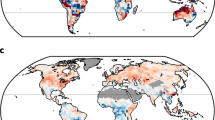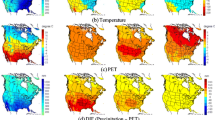Abstract
This study analyzed trends and variability in climatic water availability (CWA) across the African continent using monthly precipitation and potential evapotranspiration (PET) over the period 1901–2015. Climatic water availability was characterized in terms of precipitation minus PET totals. Predictability of the variation in CWA was tested using climate indices. Large positive values of the CWA (or few drought incidents) were confined to areas (such as sub-region along the Gulf of Guinea, the western part of the equatorial region, and the Ethiopian Highlands) that receive large amounts of precipitation. Drought incidence in these areas was generally low and characterized by severity in the range 0–44% indicating moderate to extreme wetness. Areas which experienced increasing CWA or wetting trends were confined within the Tropics. These wetting trends were mostly insignificant (p > 0.05). Drying trends (or decreasing CWA) occurred mainly in areas outside the Tropics. These drying trends (especially in the CWA of the months from April to September) were mainly significant (p < 0.05) over the Sahara desert. CWA variability in the southern and eastern parts of Africa was negatively and positively correlated with Niño 3, respectively. Variability of the East African CWA was also positively correlated with the Indian Ocean Dipole (IOD). CWA variability in West Africa (or Sahel) was negatively correlated with Niño 3. Variability of West African CWA was also linked to changes in the sea surface temperature over the Atlantic Ocean. Based on multiple linear regression, predictability of variation in CWA using combinations of climate indices varied across regions and among time scales. For instance, using combination of IOD and Niño 3 as predictors, up to about 40% and less than 10% of the total variance in CWA across East Africa and area north of the Sahel belt could be explained, respectively.










Similar content being viewed by others
Availability of data and material
The link that can be used to download the data used in this study was provided within the paper.
Code availability
The codes used for computing SNIPE and detecting trends can be obtained from the author upon request.
Change history
04 August 2021
A Correction to this paper has been published: https://doi.org/10.1007/s00704-021-03738-2
References
Almazroui M, Saeed F, Saeed S, Islam MN, Ismail M, Klutse NAB, Siddiqui MH (2020) Projected change in temperature and precipitation over Africa from CMIP6. Earth Syst Environ 4:455–475
Dai AG (2012) Drought under global warming: a review. Wiley Interdiscip Rev-Clim Change 3(6):617
Delworth TL, Mann ME (2000) Observed and simulated multi-decadal variability in the Northern Hemisphere. Clim Dyn 16:661–676
Dong B, Sutton RT, Highwood E, Wilcox L (2014) The impacts of European and Asian anthropogenic sulfur dioxide emissions on Sahel precipitation. J Clim 27:7000–7017
Dutra E, Magnusson L, Wetterhall F, Cloke HL, Balsamo G, Boussetta S, Pappenberger F (2013) The 2010–2011 drought in the Horn of Africa in ECMWF reanalysis and seasonal forecast products. Int J Climatol 33:1720–1729
Ezekiel M (1930) Methods of correlational analysis. New York: Wiley
Folland CK, Parker DE, Palmer TN (1986) Sahel rainfall and worldwide sea temperatures, 1901–85. Nature 320:602–607
Gebremeskel G, Tang Q, Sun S, Huang Z, Zhang X, Liu X (2019) Droughts in East Africa: causes, impacts and resilience. Earth-Sci Rev 193:146–161
Harris I, Jones PD, Osborn TJ, Lister DH (2014) Updated high resolution grids of monthly climatic observations–the CRU TS3.10 dataset. Int J Climatol 34:623–642
Hillbruner C, Moloney G (2012) When early warning is not enough—lessons learned from the 2011 Somalia Famine. Glob Food Sec 1:20–28
Horel JD (1982) On the annual cycle of the tropical Pacific atmosphere and ocean. Mon Weather Rev 110:1863–1878
Hwang Y-T, Frierson DMW, Kang SM (2013) Anthropogenic sulfate aerosol and the southward shift of tropical precipitation in the late 20th century. Geophys Res Lett 40:1–6
Ilori OW, Ajayi VO (2020) Change detection and trend analysis of future temperature and rainfall over West Africa. Earth Syst Environ 4:493–512
Janicot S, Harzallah A, Fontaine B, Moron V (1998) West African monsoon dynamics and Eastern Equatorial Atlantic and Pacific SST anomalies (1970–88). J Clim 11:1874–1882
Jones PD, Jonsson T, Wheeler D (1997) Extension to the North Atlantic oscillation using early instrumental pressure observations from Gibraltar and south-west Iceland. Int J Climatol 17(13):1433–1450
Kerr RA (1985) Fifteen years of African drought. Science 227(4693):1453–1454
Klutse NAB, Quagraine KA, Nkrumah F, Quagraine KT, Berkoh-Oforiwaa B, Dzrobi JF, Sylla MB (2021) The climatic analysis of summer monsoon extreme precipitation events over West Africa in CMIP6 simulations. Earth Syst Environ 5:25–41
Knudsen M, Jacobsen B, Seidenkrantz MS et al (2014) Evidence for external forcing of the Atlantic Multidecadal Oscillation since termination of the Little Ice Age. Nat Comm 5:3323. https://doi.org/10.1038/ncomms4323
Landman WA, Beraki A (2012) Multi-model forecast skill for midsummer rainfall over southern Africa. Int J Climatol 32(2):303–314
Le JA, El-Askary HM, Allali M, Sweliem H, Piechota TC, Struppa DC (2020) Characterizing El Niño-Southern Oscillation effects on the Blue Nile Yield and the Nile River Basin precipitation using empirical mode decomposition. Earth Syst Environ 4:699–711
Liebmann B, Hoerling MP, Funk C, Bladé I, Dole RM, Allured D, Quan X, Pegion P, Eischeid JK (2014) Understanding recent Eastern Horn of Africa rainfall variability and change. J Clim 27 (23):8630–8645
Lindesay JA (1988) South African rainfall, the southern oscillation and a southern hemisphere semi-annual cycle. J Climatol 8(1):17–30
Lyon B (2014) Seasonal drought in the Greater Horn of Africa and its recent increase during the March-May long rains. J Clim 27(21):7953–7975
Manatsa D, Chingombe W, Matsikwa H, Matarira CH (2008) The superior influence of Darwin sea level pressure anomalies over ENSO as a simple drought predictor for Southern Africa. Theor Appl Climatol 92:1–14
Mann ME, Zhang Z, Rutherford S, Bradley RS, Hughes MK, Shindell D et al (2009) Global signatures and dynamical origins of the little ice age and medieval climate anomaly. Science 326:1256–1260
McKee T, Doesken N, Kleist J (1993) The relationship of drought frequency and duration to time scales. In: Proceedings of the 8th Conference of Applied Climatology. Anaheim: American Meteorological Society, pp. 179–184
Mwangi E, Wetterhall F, Dutra E, Di Giuseppe F, Pappenberger F (2014) Forecasting droughts in East Africa. Hydrol Earth Syst Sci 18(2):611–620
Nicholson SE (2014) A detailed look at the recent drought situation in the Greater Horn of Africa. J Arid Environ 103:71–79
Nicholson SE (2015) Long-term variability of the East African ‘short rains’ and its links to large-scale factors. Int J Climatol 35(13):3979–3990
Nicholson SE, Kim J (1997) The relationship of the El Niño–southern oscillation to African rainfall. Int J Climatol 17:117–135
Ntale HK, Gan TY (2003) Drought indices and their application to East Africa. Int J Climatol 23(11):1335–1357
Omute P, Corner R, Awange JL (2012) The use of NDVI and its derivatives for monitoring Lake Victoria’s water level and drought conditions. Water Resour Manage 26(6):1591–1613
Onyutha C (2017) On rigorous drought assessment using daily time scale: non-stationary frequency analyses, revisited concepts, and a new method to yield non-parametric indices. Hydrology 4(4):48. https://doi.org/10.3390/hydrology4040048
Onyutha C (2018) Trends and variability in African long-term precipitation. Stoch Environ Res Risk Assess 32:2721–2739. https://doi.org/10.1007/s00477-018-1587-0
Onyutha C (2019) Hydrological model supported by a step-wise calibration against sub-flows and validation of extreme flow events. Water 11(2):244. https://doi.org/10.3390/w11020244
Onyutha C (2020a) Analyses of rainfall extremes in East Africa based on observations from rain gauges and climate change simulations by CORDEX RCMs. Clim Dyn 54:4841–4864
Onyutha C (2020b) Trends and variability of temperature and evaporation over the African continent: relationships with precipitation. Atmósfera. https://doi.org/10.20937/ATM.52788
Onyutha C (2021) Graphical-statistical method to explore variability of hydrological time series. Hydrol Res 52(1):266–283
Onyutha C, Willems P (2017) Space-time variability of extreme rainfall in the River Nile basin. Int J Climatol 37(4):4915–4924
Otterå OH, Bentsen M, Drange H, Suo L (2010) External forcing as a metronome for Atlantic multidecadal variability. Nat Geosci 3:688–694
Parker D, Folland C, Scaife A, Knight J, Colman A, Baines P, Dong B (2007) Decadal to multidecadal variability and the climate change background. J Geophys Res 112:D18115. https://doi.org/10.1029/2007JD008411
Prospero JM, Lamb PJ (2003) African droughts and dust transport to the Caribbean: climate change implications. Science 302(5647):1024–1027. https://doi.org/10.1126/science.1089915
Rayner NA, Parker DE, Horton EB, Folland CK, Alexander LV, Rowell DP, Kent EC, Kaplan A (2003) Global analyses of sea surface temperature, sea ice, and night marine air temperature since the late nineteenth century. J Geophys Res 108(D14):4407
Reason CJC, Allan RJ, Lindesay JA, Ansell TJ (2000) ENSO and climatic signals across the Indian Ocean Basin in the global context. Part I: Interannual composite patterns. Int J Climatol 20(11):1285–1327
Rojas O, Vrieling A, Rembold F (2011) Assessing drought probability for agricultural areas in Africa with coarse resolution remote sensing imagery. Remote Sens Environ 115:343–352
Rouault M, Richard Y (2005) Intensity and spatial extent of droughts in southern Africa. Geophys Res Lett 32:L15702. https://doi.org/10.1029/2005GL022436
Sen PK (1968) Estimates of the regression coefficient based on Kendall’s tau. J Am Stat Assoc 63:1379–1389
Shanko D, Camberlin P (1998) The effects of the Southwest Indian Ocean tropical cyclones on Ethiopian drought. Int J Climatol 18(12):1373–1388
Sheffield J, Wood EF, Chaney N, Guan K, Sadri S, Yuan X, Olang L, Amani A, Ali A, Demuth S, Ogallo L (2014) A drought monitoring and forecasting system for sub-Sahara African water resources and food security. Bull Am Meteorol Soc 95(6):861–882
Shiferaw B, Tesfaye K, Kassie M, Abate T, Prasanna BM, Menkir A (2014) Managing vulnerability to drought and enhancing livelihood resilience in sub-Saharan Africa: technological, institutional and policy options. Weather Clim Extr 3:67–79
Theil H (1950) A rank-invariant method of linear and polynomial regression analysis. Neder Akad Wet Ser A 53:386–392
Tierney JE, Smerdon JE, Anchukaitis KJ, Seager R (2013) Multidecadal variability in East African hydroclimate controlled by the Indian Ocean. Nature 493:389–392
Trenberth K (1997) The definition of El Niño? Bull Am Meteorol Soc 78(12):2771–2777
Uhe P, Philip S, Kew S, Shah K, Kimutai J, Mwangi E, van Oldenborgh GJ, Singh R, Arrighi J, Jjemba E, Cullen H (2017) Attributing drivers of the 2016 Kenyan drought. Int J Climatol 38:554–568
van Oldenborgh GJ, te Raa LA, Dijkstra HA, Philip SY (2009) Frequency- or amplitude-dependent effects of the Atlantic meridional overturning on the tropical Pacific Ocean. Ocean Sci 5:293–301
Verschuren D, Laird KR, Cumming BF (2000) Rainfall and drought in equatorial east Africa during the past 1,100 years. Nature 403(6768):410–414
Vicente-Serrano SM, Beguería S, López-Moreno JI (2010) A multiscalar drought index sensitive to global warming: the standardized precipitation evapotranspiration index. J Clim 23:1696–1718
Viste E, Korecha D, Sorteberg A (2013) Recent drought and precipitation tendencies in Ethiopia. Theor Appl Climatol 112(3–4):535–551
Zhao T, Dai A (2015) The magnitude and causes of global drought changes in the twenty-first century under a low–moderate emissions scenario. J Clim 28(11):4490–4512
Acknowledgements
The author acknowledges that the data used in this study were from the Climatic Research Unit (CRU) (i.e., Time-Series (TS) version 4.0 or CRU TS4.0).
Author information
Authors and Affiliations
Contributions
The entire work under this study was solely undertaken by the sole author.
Corresponding author
Ethics declarations
Ethics approval
This research did not involve human subjects. Meteorological datasets used in this study can all be obtained from publicly accessible archives.
Consent to participate
This research did not involve human subjects.
Consent for publication
This research did not involve personal information for which consent was to be sought.
Conflict of interest
The author declares no competing interests.
Additional information
Publisher’s note
Springer Nature remains neutral with regard to jurisdictional claims in published maps and institutional affiliations.
The original online version of this article was revised: In this article, typographical and minor mistakes should be corrected in sections 1, 2.1.2, 2.2, 2.4.1, 3.2 and Eqs. 8–10.
Rights and permissions
About this article
Cite this article
Onyutha, C. Long-term climatic water availability trends and variability across the African continent. Theor Appl Climatol 146, 1–17 (2021). https://doi.org/10.1007/s00704-021-03669-y
Received:
Accepted:
Published:
Issue Date:
DOI: https://doi.org/10.1007/s00704-021-03669-y




